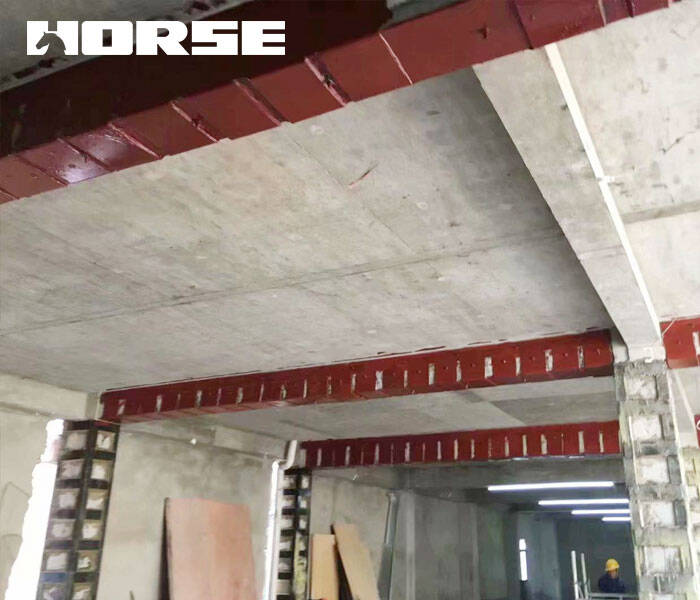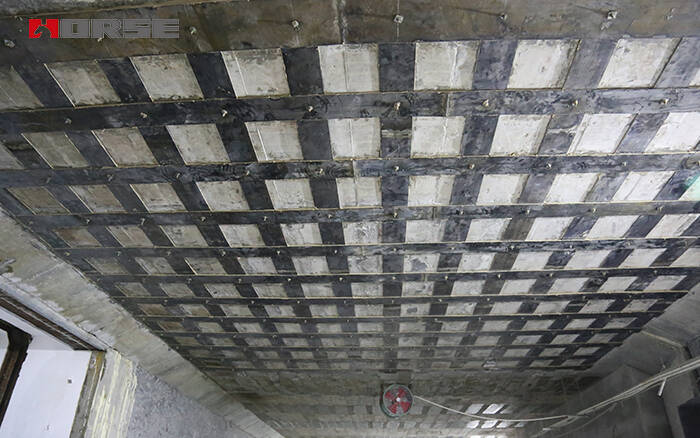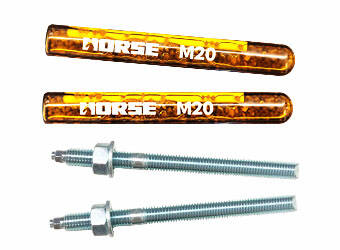Solutions
Horse Construction offers full range of structural strengthening materials with technical supports, documentation supports, products supports, project supports.
The Main Points Of Bonding Steel Plate Reinforcement

When the original building cannot meet the needs in a certain aspect, it is necessary to strengthen the building! There are many ways to strengthen the treatment, such as planting steel bars, bonding steel, bonding carbon fiber cloth and so on. Today I’m going to talk about bonding steel reinforcement. The construction process of bonding steel reinforcement is very simple, today I will talk about what needs to be paid attention to when bonding steel reinforcement.
1 This construction method is suitable for reinforced concrete structures, not for plain concrete components;
2 For reinforced concrete structural members, the measured concrete strength on site is lower than c15, and the positive tensile bonding strength of the concrete surface shall not be lower than 1.5Mpa;
3 When bonding steel plates to reinforce reinforced concrete structures, the steel plate should be designed to bear the axial stress only.
4 When using steel glue to stick steel plates to reinforce the concrete structure, the environmental temperature for long-term use should not be higher than 60°C. When concrete structures in special environments (such as high temperature, high humidity, medium erosion, radiation, etc.) are reinforced by this method, in addition to corresponding protective measures in accordance with the current relevant national standards, adhesives resistant to environmental factors should be used . And paste it according to the special process requirements
5 When using pasted steel plates to reinforce reinforced concrete structures, measures should be taken to remove or remove most of the live loads acting on the structure;
6 The thickness of the steel plate pasted by hand gluing should not be greater than 5mm. The thickness of the steel plate with pressure-injection glued structure should not be greater than 10mm, and it should be designed according to the welded joint structure of the externally bonded steel reinforcement method;
7 When the reinforced concrete bending member is reinforced by the normal section, the reinforcing plate that is continuously pasted along the axial direction of the member on the common surface should be extended to the edge of the support. And should be at the end of the steel plate (including the cutoff) and on both sides of the concentrated load point, U-shaped steel hoop plates (for beams) or transverse steel strips (for plates) should be set for anchoring;

8 For beams, the following anchoring measures shall be adopted when the extension length to the edge of the support still does not meet the requirements:
1) For beams, U-shaped hoops should be uniformly set within the extension length, and a reinforcing hoops should be set at the end of the extension length. The bonding height of the U-shaped hoops should be the height of the beam section. If the beam has flanges (or cast-in-place floor slabs), it should extend to its bottom. The width of the U-shaped hoop should not be less than 2/3 of the width of the reinforced steel plate, and should not be less than 80mm. The middle hoop should not be less than 1/2 of the width of the reinforced steel plate. And it should not be less than 40mm, and the upper end of the U-shaped hoop should be provided with longitudinal steel bead. The gap under the bead should be filled with glued steel spacers;
2) For the plate, the steel bead perpendicular to the direction of the stressed steel plate shall be set up in the extended length range. The steel bead shall be evenly arranged within the extension length. And the width of a bead at the end of the extension length should not be less than 3/5 of the width of the bending reinforced steel plate, and the thickness of the steel bead should not be less than 1/2 of the thickness of the bending reinforced steel plate.
9 When steel plates are used to reinforce the positive-cut bearing capacity of the negative moment area of the flexural member, the following structural measures should be taken:
1) When there is no obstacle at the support, the steel plate should be continuously pasted within the scope of the negative bending moment envelope; the cut-off point of its extension length should be determined according to the design and relevant specifications. On the side where the end support cannot be extended, the anchoring treatment shall be carried out according to the construction method of this code;
2) Although there are obstacles at the support, when there is a cast-in-place slab on the beam, it is allowed to bypass the column position and paste the steel plate on the slab surface within 4 times the thickness Hb of the beam side.
3) When there is no cast-in-place slab on the beam, or the support of negative bending moment needs to be reinforced anchoring measures, the anchoring treatment can be carried out in accordance with the construction method of relevant specifications.
10 When the reinforced bending member needs to be pasted with more than one layer of steel plate, the cut-off positions of the two adjacent layers of steel plate should be staggered by not less than 300mm. And should add U-shaped hoop (to beam) or transverse bead (to plate) at the cutoff point for anchoring;
11 When using pasted steel hoop to reinforce the oblique section bearing capacity of reinforced concrete beams or large eccentric compression members, the structure should meet the following requirements:
1) Closed hoop or U-shaped hoop with anchor should be used; if hoop is only required for construction, general U-shaped hoop can also be used;
2) The direction of force should be perpendicular to the axial direction of the member.
3) The net spacing SSP of closed hoops and U-shaped hoops, N should not be greater than 0.7 times the maximum stirrup spacing specified in the current national standard "Specification for Design of Concrete Structures" GB50010, and should not be greater than 0.25 times the beam height.
4) The bonding height of the hoop plate should meet the design requirements. Generally, the upper end of the U-shaped hoop should be pasted with longitudinal steel bead for anchoring. Under the steel bead, glue the steel backing plate to fill in the gap in the sales;
5) When the section height of the beam (or the height of the web) H≥600mm, a longitudinal waist steel bead should be added at the waist of the beam.
These problems need to be paid attention to in the construction of bonded steel reinforcement. But you must also pay attention to the selection of reinforcement materials, especially the selection of steel plates and glued steel glue! Material is the basis of reinforcement, the reinforcement materials are selected well, and the construction is done well, the reinforcement effect will be good!
You can find anything here you are in need of, have a trust trying on these products, you will find the big difference after that.

High-strength anchor bolt with vinyl resin as main materials, composed of selected quartz sands, curing agents and glass tubes

Two-component epoxy modified epoxy structural strengthening adhesive for bonded steel plate to concrete

Modified epoxy resin structural perfusion adhesive, specifically for supporting adhesive bonded steel reinforcement